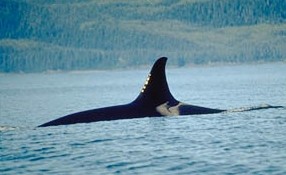Dorsal fin
|
|
A dorsal fin is a fin located on the backs of fishes, whales, dolphins and porpoises. Its main purpose is to stabilise the animal against rolling and assist in sudden turns. Some animals have developed dorsal fins with protective functions, such as spines or venom. Many catfish can lock the leading ray of the dorsal fin in an extended position to discourage predation or to wedge themselves into a crevice.
Dorsal fins come in a variety of shapes and sizes:
Fish
There may be two dorsal fins, a long fin merged with the caudal fin (tail), or no dorsal fin at all, as with the knifefish.
See also: fish anatomy
Whales, Dolphins and Porpoises
In relation to the size of the creature, the dorsal fin of the male orca is quite large, as much as 1.8 m high. Many (30-100%) captive killer whales (orcas) experience collapse of the dorsal fin, possibly because lack of exercise through turning leads to diminished muscle tone. (Only about 1% of wild orcas have collapsed dorsal fins.) The dorsal fins of most other whales are relatively small. The bowhead whale has no dorsal fin at all, as an evolutionary adaptation to its life spent cruising under icepack.
The dorsal fins of whales develop distinctive nicks and wear patterns with time, and this fact is used by wildlife biologists to identify individuals in the field.

